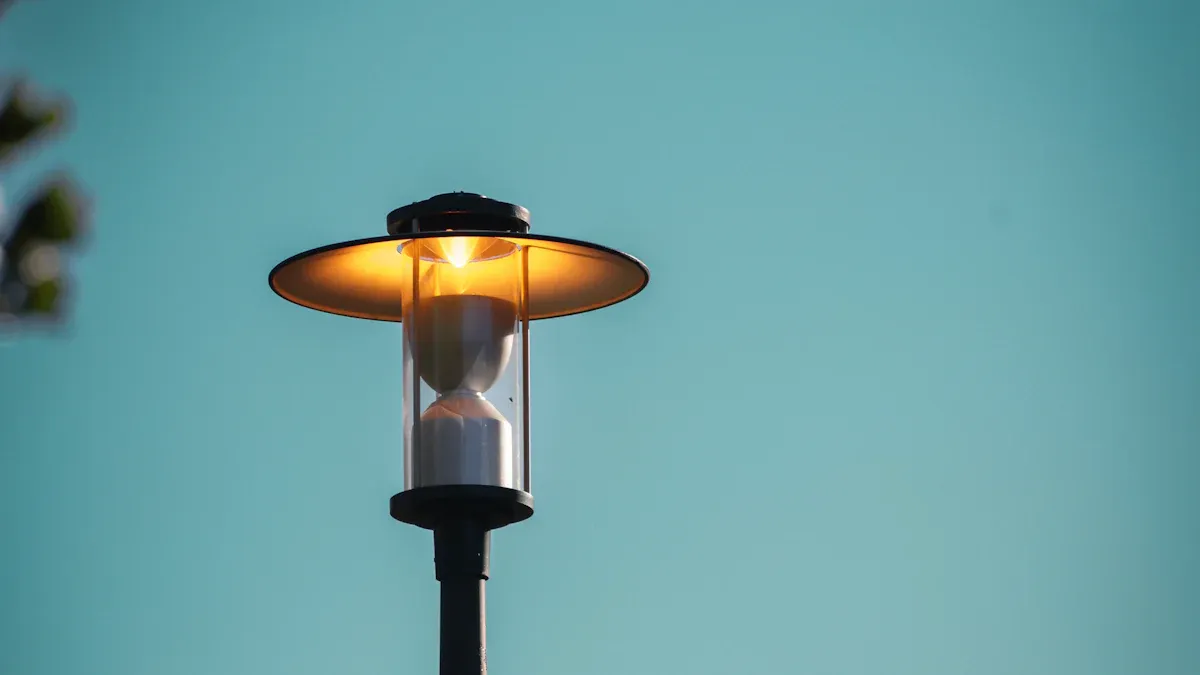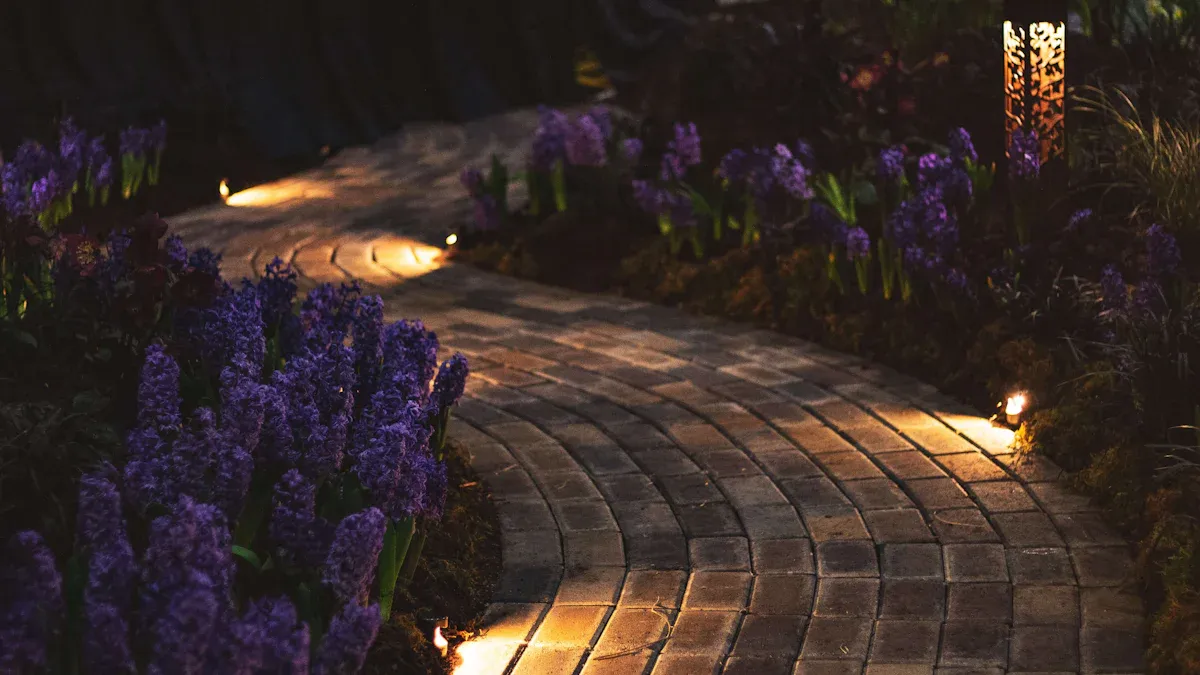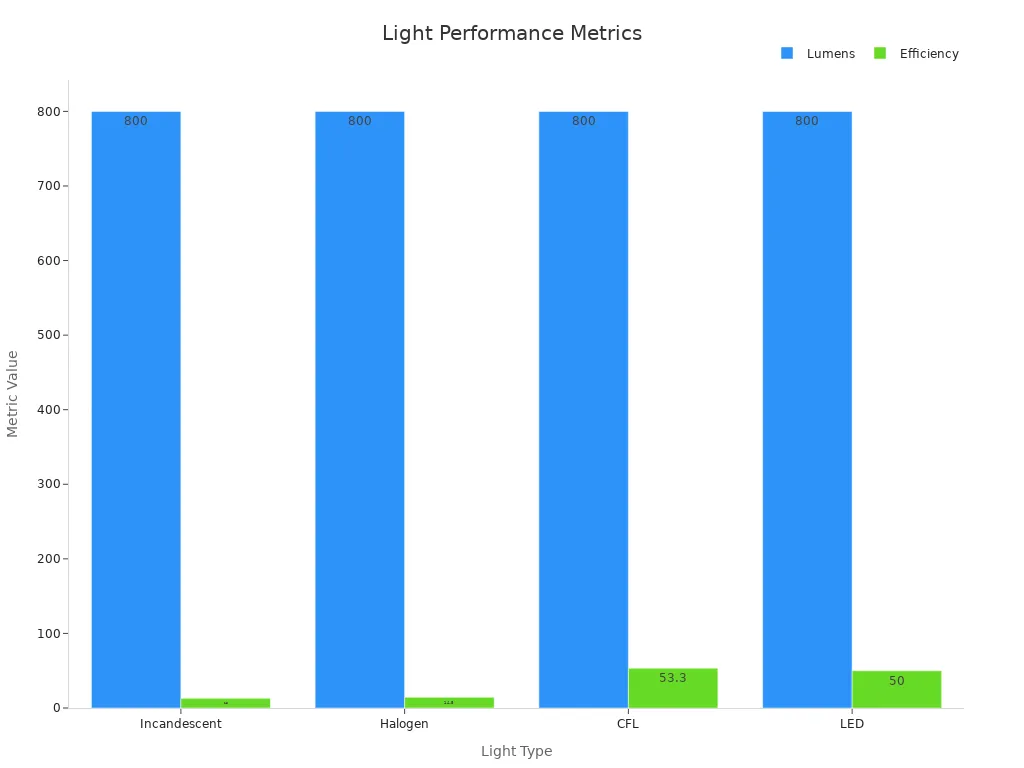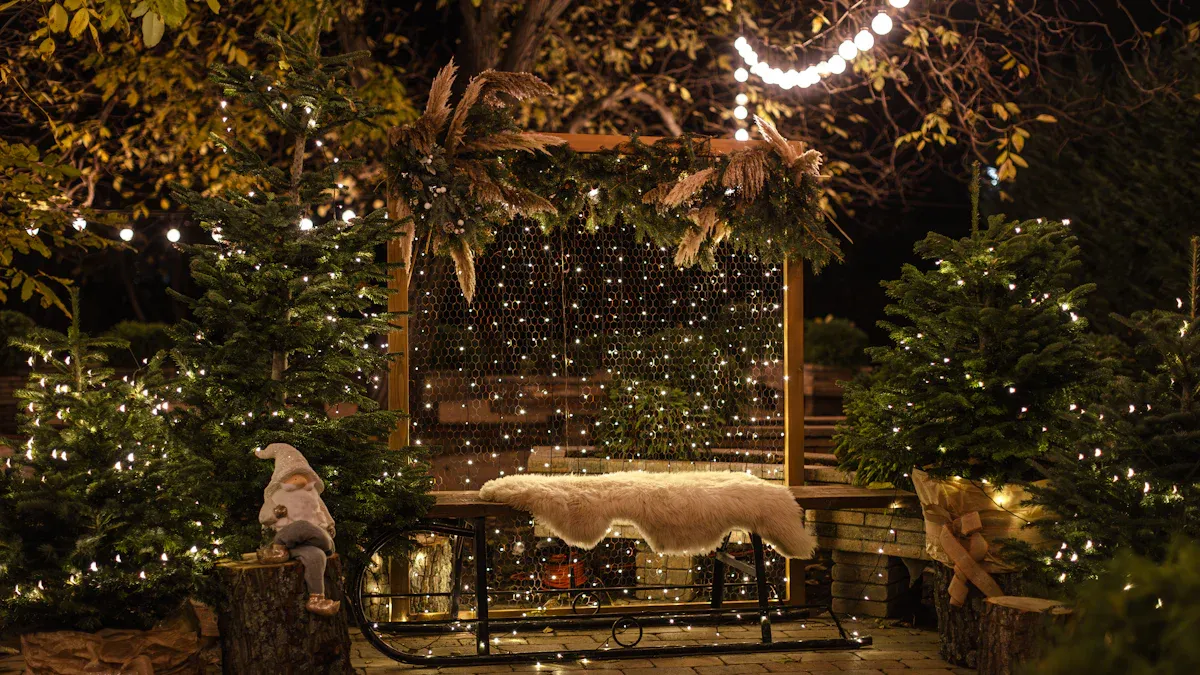Outdoor Lights: Types, Applications, and Installation Best Practices

Outdoor lights are essential for enhancing the safety of your home’s exterior. They improve visibility at night and help prevent accidents. Quality lighting can also enhance the aesthetic appeal of your home after dark. Many homeowners feel more content and notice an increase in their property value with the addition of outdoor lights. For example, homes featuring bright yards and illuminated pathways often attract potential buyers due to their appealing appearance. Additionally, outdoor lights, such as LED lights, contribute to your home’s security by deterring intruders and making outdoor spaces more functional and inviting. If you want to learn more about our product offerings, feel free to check out the About Us section on our website.
Key Takeaways
Outdoor lights improve safety and help you see better at night. They also make your home look welcoming and safe.
Pick LED lights to save energy and money. LED lights last longer and use less electricity.
Design your outdoor lighting plan to light up your yard evenly. Use lights to show off important areas or features.
Keep outdoor lights clean and check for damage often. This helps them work well and last a long time.
Hire experts for tricky setups to keep things safe and working properly.
Types of Outdoor Lights

Outdoor lights come in different types, each with a special use. Knowing these types helps you pick the best lights for your space.
Ambient Outdoor Lights
Ambient lights give off a soft glow that lights up big areas. They are great for patios, decks, and paths, creating a cozy feel. Many people choose LEDs for ambient lighting because they save energy and last long.
💡 Tip: For patios and decks, use 200-400 lumens. For pathways, 100-200 lumens is enough. This keeps the area bright but still comfortable.
Here’s how common ambient lights compare in brightness and energy use:
Light Type | Watts Used | Lumens Produced | Efficiency (lumens/watt) |
|---|---|---|---|
Incandescent | 60W | 800 lm | 13 lm/W |
Halogen | 55W | 800 lm | 14.5 lm/W |
CFL | 15W | 800 lm | 53.3 lm/W |
LED | 16W | 800 lm | 50 lm/W |
LEDs are the best choice because they are efficient and last longer.

Task Outdoor Lights
Task lights are bright and focus on specific areas. They are perfect for driveways, stairs, and outdoor kitchens. These lights make spaces safer and easier to use.
🔍 Note: Security lights need 700-1300 lumens to light up large areas well.
LEDs have changed task lighting by saving energy and needing less upkeep. They also work with smart systems. The demand for outdoor LED lights is growing fast, with a 13.10% yearly growth expected from 2025 to 2033. This shows how popular efficient lighting is becoming.
Accent Outdoor Lights
Accent lights highlight special parts of your yard, like trees or statues. They make your outdoor space look more interesting and beautiful.
🌟 Tip: Spotlights or floodlights are great for accent lighting. Use them to show off key features in your yard.
Energy-saving LEDs are popular for accent lighting. They give bright, focused light while using little power. Certifications like ENERGY STAR and DLC prove these lights are energy-efficient and eco-friendly.
Certification | Description |
|---|---|
ENERGY STAR | Meets strict energy-saving rules set by the EPA. |
UL Listing | Tested for electrical safety and reliability. |
ETL Listing | Ensures safety and dependability through testing. |
RoHS Compliance | Free of harmful materials like mercury or lead. |
DLC Certification | Marks energy-saving products that may qualify for rebates. |
Accent lights turn your yard into a masterpiece, showing off its best features.
Common Outdoor Lighting Fixtures
Outdoor lights come in many styles for different uses. Picking the right one makes your yard safer and nicer. Below are some popular choices.
Path Lights
Path lights brighten walkways, driveways, and garden paths at night. They sit close to the ground and shine downward to prevent glare. These lights make walking safer and add beauty to your yard.
When choosing path lights, look at these features:
Feature | What It Measures |
|---|---|
Lighting Quality (LQ) | Shows how well the light works outdoors. |
Brightness Level (BL) | Rates how bright the light is, like ‘strong’ or ‘sparkling.’ |
Comfort Level (CL) | Checks if the light feels pleasant in the space. |
LED path lights are a top pick because they save energy and last long. They use half the energy of older lamps and need little upkeep.
Wall-Mounted Outdoor Lights
Wall-mounted lights are useful and stylish. You can put them near doors, garages, or patios for better lighting and safety. These lights are tough and can handle bad weather and bumps.
Modern LED wall lights have extra perks. They cut energy bills and work with smart systems. For example, smart controls adjust brightness based on activity, making them last longer and work better.
Strong features include:
Protection from rust and damage.
Parts that work in very hot or cold weather.
These qualities make wall-mounted lights a solid choice for outdoor use.
String Outdoor Lights
String lights create a cozy vibe, great for parties or decoration. Hang them on patios, pergolas, or trees to make your space charming. LED string lights use less power than older bulbs.
Here’s how string lights compare:
Type of Light | Lifespan (Hours) | Energy Use Comparison |
|---|---|---|
LED String Lights | Uses less energy than old-style bulbs. | |
Solar-Powered Lights | 16-20 years | Saves more energy than regular bulbs. |
Incandescent Bulbs | 1,000 - 2,000 | Uses more energy than LEDs. |
LED string lights last longer, so you don’t replace them often. Solar-powered ones are eco-friendly and use sunlight for power.
Floodlights
Floodlights are strong lights that brighten big outdoor spaces. They work well for driveways, backyards, and building walls. These lights make areas safer and easier to see at night.
💡 Tip: Motion-sensor floodlights save power and boost security.
Floodlights have different beam angles for various uses:
Wide beams light up large spaces like gardens or parking lots.
Narrow beams focus on small areas like doors or statues.
Knowing the beam angle helps you place floodlights better. Wide beams are good for general lighting, while narrow beams highlight specific spots. Brightness is measured in lumens. More lumens mean stronger light, which is great for big spaces.
Feature | Details |
|---|---|
3000-3300 Lm | |
Voltage Range | AC 85-265V |
Beam Width (at 6m) | 3.3 meters |
Light Strength (at 6m) | 40 LUX |
Floodlights are tough and last long. Many can handle bad weather easily. LED floodlights use less energy and work for years.
Spotlights
Spotlights shine light on specific objects or areas. They are great for showing off trees, statues, or cool yard designs. Spotlights have narrow beams, making them perfect for dramatic lighting effects.
🌟 Note: Spotlights highlight your yard’s best features.
LED spotlights are popular because they save energy and shine brightly. Many have adjustable heads to aim light where you need it. This makes them useful for both decoration and practical lighting.
Place spotlights carefully when setting them up. Put them at the base of what you want to highlight and aim them upward. This adds depth and makes your yard look amazing.
Deck and Step Lights
Deck and step lights make outdoor spaces safer and more stylish. They are placed on stairs, railings, or deck edges to help people see better at night. These lights lower the chance of tripping or falling.
Benefit | How It Helps |
|---|---|
Prevents Falls | |
Improves Visibility | Boosts clear sight by 80% |
Increases Security | Stops 70% of intruders (FBI stats) |
Deck and step lights come in many styles, like recessed, mounted, or solar-powered. LED lights are a favorite because they use less power and last longer. Some lights have sensors that turn on at night automatically.
🔍 Tip: Space step lights evenly for a neat look and even lighting.
Deck and step lights combine safety with beauty, making outdoor areas more enjoyable.
Applications of Outdoor Lights

Making Your Home Look Better
Outdoor lights can make your home look amazing. Permanent holiday lights are becoming more popular every year. They grow by 30% annually, based on market data. These lights make your home prettier and save money over time. Permanent lights cost about $3,500 to install. This is the same as paying for temporary lights three times. Forrest Evans, an expert installer, says permanent lights improve curb appeal more than regular ones. This extra beauty can attract buyers if you decide to sell your home.
Fact Type | Details |
|---|---|
Market Growth | Permanent holiday lights grow 30% each year. |
Expert Opinion | Forrest Evans says permanent lights look better than traditional ones. |
Cost Comparison | Permanent lights cost $3,500, equal to three temporary light installations. |
Selling Impact | Permanent lights can help attract buyers when selling your home. |
Keeping Your Property Safe
Outdoor lights help keep your home safe. Bright lights lower the chance of accidents and scare away intruders. A study found that switching to LED lights cut nighttime crimes by 36%. Motion-sensor lights are very useful. They turn on only when needed, saving energy and boosting security. Lighting up dark areas and paths makes your home safer for family and visitors.
Study Source | Result | Details |
|---|---|---|
NYC Police and Housing Authority | 36% drop | LED lights reduced nighttime crimes in upgraded areas. |
Making Outdoor Spaces Useful
Outdoor lights make your yard usable at night. You can enjoy barbecues or relax on your patio with good lighting. Surveys show people prefer bright spaces over hidden ones. This helps them feel safer and react to dangers quickly. Lights also create a warm and welcoming vibe. String lights or deck lights can turn your yard into a cozy and functional space.
Survey Result | Meaning |
|---|---|
People like light around them | Helps them respond to danger more easily. |
Visibility is preferred | Lighting makes outdoor spaces feel safer and inviting. |
Highlighting Landscaping Features
Outdoor lights can make your yard look amazing at night. Placing lights carefully can show off trees, bushes, fountains, or garden statues. This makes your yard more beautiful and welcoming.
Key Areas to Highlight
Here are some spots to light up in your yard:
Trees and Shrubs: Shine lights upward for bold shadows or downward for a soft glow.
Water Features: Use underwater lights to brighten ponds or fountains with a magical effect.
Garden Paths: Pathway lights help people walk safely and show off your garden’s design.
Architectural Elements: Light up pergolas, gazebos, or stone walls to make them stand out.
💡 Tip: Pick warm white lights (2700K-3000K) for a natural look that matches plants and stones.
Lighting Techniques
Try these methods to get the look you want:
Silhouetting: Put a light behind a tree or statue to create an outline.
Shadowing: Place a light in front of an object to make cool shadows on a wall.
Grazing: Aim light at an angle across rough surfaces like brick or bark to show details.
Choosing the Right Fixtures
The right fixtures last longer and work better. Look for:
Fixture Type | Best For | Benefits |
|---|---|---|
Spotlights | Trees, statues | Bright, adjustable light beams |
Submersible Lights | Ponds, fountains | Waterproof and durable |
Path Lights | Walkways, flower beds | Safe and stylish lighting |
🌟 Note: Choose LED fixtures with weatherproof ratings like IP65 or higher for outdoor use.
Lighting up your yard’s features can make it look elegant and inviting for everyone to enjoy.
Installation Best Practices for Outdoor Lights
Planning Your Outdoor Lighting Layout
A good lighting plan makes outdoor spaces useful and attractive. First, decide which areas need lighting, like paths, patios, or gardens. Think about why you need each light. For example, path lights make walking safer, and accent lights show off yard features.
When planning, keep these points in mind:
Placing lights correctly makes spaces more comfortable and useful.
A smart design saves energy and lowers electricity bills.
Balanced lighting avoids areas being too bright or too dark.
Draw a simple map of your yard. Mark where lights should go and choose the right type for each spot. This helps you see the final look and ensures no area is missed.
💡 Tip: Use warm white lights for cozy spaces and cool white lights for work areas like stairs or driveways.
Choosing Between DIY and Professional Installation
Deciding to install lights yourself or hire help depends on your skills, budget, and project size. DIY saves money and feels rewarding but needs basic electrical skills and tools.
Hiring a professional has benefits. They ensure safe wiring, good connections, and perfect light placement. Experts handle tricky setups like smart systems or hard-to-reach spots. Though it costs more, it saves time and avoids mistakes.
Here’s how to choose:
DIY is great for simple tasks like hanging string lights or using solar lights.
Professionals are better for big projects or electrical wiring jobs.
Hiring experts improves your home’s look and ensures lasting results.
🔍 Note: If you’re unsure about wiring, it’s safer to call an electrician.
Ensuring Electrical Safety
Safety is key when setting up outdoor lights. Use outdoor-rated fixtures and cables that resist weather like rain or heat.
Follow these safety steps:
Turn off power at the breaker before starting work.
Use GFCIs to stop electrical shocks.
Cover connections with waterproof tape or covers to keep them dry.
Avoid overloading circuits by checking the total wattage of your lights.
Check your lights often for damage like worn wires or loose parts. Fix or replace broken items quickly to stay safe.
⚠️ Caution: Don’t try electrical work if you’re not experienced. Hire a pro to meet safety rules.
Using Energy-Efficient Outdoor Lights
Switching to energy-efficient outdoor lights saves money and helps the planet. Old-style bulbs use more power and need frequent replacements, costing more over time. On the other hand, LED lights are a smarter choice. They use up to 80% less energy and last 15,000 to 50,000 hours. This means fewer replacements and lower electric bills.
LED lights turn electricity into light with very little heat. This makes them use less energy and reduces the need for extra power, which lowers pollution. Many LED lights also have smart features like motion sensors. These sensors save energy by turning lights on only when needed. For example, motion-sensor floodlights light up your driveway when someone walks by, saving power and adding safety.
When picking energy-saving outdoor lights, think about these points:
Lifespan: Pick lights that last longer to avoid frequent changes.
Smart Features: Choose lights with dimmers or motion sensors to save power.
Certifications: Look for ENERGY STAR labels to ensure high energy efficiency.
Switching to LED lights gives you brighter, longer-lasting lighting while helping the environment.
🌟 Tip: Use warm white LEDs (2700K-3000K) for a cozy feel or cool white LEDs (4000K-5000K) for work areas like driveways or stairs.
Maintenance Tips for Longevity
Taking care of your outdoor lights helps them last longer and work better. Regular maintenance keeps them looking good and avoids costly repairs. Check your lights often for problems like worn wires or loose parts. Fixing small issues early can prevent bigger ones later.
Here are some easy tips to keep your lights in good shape:
Clean Fixtures Often: Dust and dirt can block light. Wipe them with a soft cloth and mild soap.
Check for Water Damage: Make sure fixtures are sealed to keep water out. Look for an IP rating of 65 or higher for better protection.
Replace Bulbs Quickly: Burnt-out bulbs can cause problems. Switch to energy-saving LEDs for even lighting.
Inspect Wiring: Look for damaged wires and cover them with waterproof tape to stay safe.
The material of your lights also matters. Polycarbonate lenses are tougher than glass or acrylic, making them better for bad weather. Fixtures that are easy to open for bulb changes can save you time and effort.
💡 Note: Space your lights evenly to avoid shadows and glare. This creates a balanced and nice-looking setup.
By following these tips, your outdoor lights will work well and last for years.
Outdoor lights help make your home safe, useful, and attractive. Planning carefully lets you put lights in the best spots. Following safety tips ensures proper and secure installation. Using energy-saving LED lights lowers costs and protects the planet. Taking care of your lights keeps them working for a long time. Good outdoor lighting creates a cozy and safe place for family and friends.
FAQ
What kind of outdoor light saves the most energy?
LED lights are the best for saving energy. They use up to 80% less power than old-style bulbs and last much longer. This makes them cheaper to use and better for the environment.
How do I pick the right brightness for outdoor lights?
Choose brightness based on the light’s purpose. Pathways need 100-200 lumens, while security lights need 700-1300 lumens. Use dimmer lights for a cozy feel and brighter ones for safety.
Can outdoor lights handle bad weather?
Yes, many outdoor lights are made to resist weather. Look for lights with an IP65 rating or higher. These can handle rain, dust, and extreme heat or cold.
Are solar lights good for outdoor spaces?
Solar lights work great in sunny places. They use sunlight to save energy and need little care. But they might not work as well in shady or cloudy areas.
How often should I check my outdoor lights?
Check your lights every few months. Clean them, look for water damage, and replace broken bulbs quickly. Regular care helps them last longer and work better.
See Also
Everything You Need to Know About LED Area Lights
Exploring LED Outdoor Lighting: Advantages and Installation Tips
Outdoor Signage Lighting: Varieties, Uses, and Installation Guidelines
Understanding LED Area Lights: Uses, Advantages, and Setup Tips
Choosing Outdoor LED Lighting: Types, Benefits, and Setup Advice

